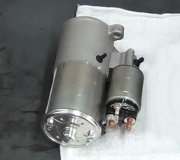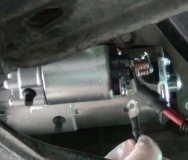20 amps is normal for a GM starter solenoid, but you weren't clear as to whether it's the link feeding to the solenoid or one of those that taps off from the larger battery terminal to feed other circuitry. GM likes to use that larger terminal as a convenient tie point rather than running numerous wires right from the battery. The disadvantage is they sit right next to the hot exhaust manifold where the heat can degrade the wires. The advantage, if you can call it that, is rain water is burned off sooner to keep the wires dry.
You buy new fuse links according to color of the insulation and you will get about 10". That's enough to cut in half and make two. You only need an inch, just so there is enough to be the "weak link in the chain" in case there's a problem.
I'm happy you didn't mention it, but it bares a comment for others who might read this while doing a search, do not just splice in a regular wire. The proper fuse link is a smaller diameter wire and the insulation won't burn. Even if you use a regular wire of the correct diameter, insurance claims adjusters know all of these things to look for to build their case and to deny claims. I only know a fraction of the things they look for but I DO know you are safe when you stick with factory-specified parts. There are a lot of things do-it-yourselfers do and don't do during a brake job that can cause them to be partially at fault for a crash when the other guy ran the red light. Good lawyers will find these things.
While working at a tv repair shop in the '70s, two insurance adjusters sifted through the smoldering remains of a tv and found that the house fire was caused by arcing power switch contacts. If they were smart enough to determine that in the '70s when we weren't quite so sue-happy, imagine what they can pin on us now!
Another misunderstood thing about fuses is their voltage rating. We select a new fuse based on its current rating; the amount of current that will flow THROUGH it, but car fuses are also rated at 32 volts and should not be used in household electronic appliances. A good fuse will have 0 volts across it, but when it blows, it could have 120 volts across it. All that voltage rating means is up 32 volts they guarantee it won't explode from the spark. Household appliance fuses are rated at 125 volts or 250 volts.
Sorry if I sounded like I'm preaching. My intent is just to repeat stuff like this every chance I get to make people aware of the liability issues we face. In your case, replacing a fuse link wire with a regular fuse is a common sense approach, but it makes more sense to do that in a circuit that might blow the fuse often. Soldering in a new fuse link takes a lot longer the second time but they typically won't fail very often.
There are two other important points to know about fuse link wires. First, to test one, just tug on it. If it acts like a wire, it's good. If it's burned open, it will act like a rubber band. The second characteristic is a little hard to comprehend unless you understand electrical theory but it has sent a lot of experienced mechanics into a state of confusion. When the link burns open, it leaves a carbon track behind at that spot, similar to the carbon track you might find inside a distributor cap. That carbon track will conduct a small amount of current. If you are troubleshooting a dead circuit, and you unplug a connector, then measure for voltage with a digital voltmeter, you will find 12 volts. For all practical purposes, a voltmeter draws no current. That means there is no voltage dropped across that carbon track and the full 12 volts you started with at the battery shows up at the voltmeter. If you use a test light instead of the voltmeter, it does draw current. Not enough current can get through the carbon track so there isn't enough voltage left at the connector to light the test light. Basically, if you're troubleshooting in a high-power circuit such as a radiator fan motor or power window motor circuit, you'll get faster and more accurate results with an inexpensive test lights vs. A high-quality voltmeter.
Wednesday, April 27th, 2011 AT 7:47 PM



